Vilayet
A vilayet (Ottoman Turkish: ولایت, "province"), also known by various other names, was a first-order administrative division of the later Ottoman Empire. It was introduced in the Vilayet Law of 21 January 1867,[1] part of the Tanzimat reform movement initiated by the Ottoman Reform Edict of 1856. The Danube Vilayet had been specially formed in 1864 as an experiment under the leading reformer Midhat Pasha. The Vilayet Law expanded its use, but it was not until 1884 that it was applied to all of the empire's provinces.[1] Writing for the Encyclopaedia Britannica in 1911, Vincent Henry Penalver Caillard claimed that the reform had intended to provide the provinces with greater amounts of local self-government but in fact had the effect of centralizing more power with the sultan and local Muslims at the expense of other communities.[2]
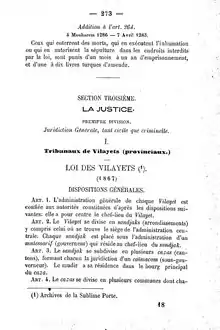
Names
The Ottoman Turkish vilayet (ولایت) was a loanword borrowed from Arabic wilāya (وِلَايَة), an abstract noun formed from the verb waliya (وَلِيَ, "to administer"). In Arabic, it had meant "province", "region", or "administration" as general ideas, but following the Tanzimat reforms the Ottoman term formalized it in reference to specific areas in a defined hierarchy.[3] It was borrowed into Albanian vilajet, Bulgarian vilayet (вилает),[4] Judaeo-Spanish vilayet, and French vilaïet and vilayet, which was used as a lingua franca among the educated Jews and Christians. It was also translated into Armenian as gawaŕ (գաւառ), Bulgarian as oblast (област), Judaeo-Spanish as provinsiya, and Greek as eparchía (επαρχία) and nomarchía (νομαρχία).[5]
The early Republic of Turkey continued to use the term vilayet until it renamed them il in the late 1920s.
Organization
The Ottoman Empire had already begun to modernize its administration and regularize its eyalets in the 1840s,[6] but the Vilayet Law extended this throughout the empire, regularizing the following hierarchy of administrative units.[1][7]
Each vilayet or province was governed by a vali appointed by the sultan.[7] Acting as the sultan's representative, he was notionally the supreme head of administration in his province,[8] subject to various caveats. Military administration was entirely separate,[7] although the vali controlled local police.[7] His council comprised a secretary (mektubci), a comptroller (defterdar), a chief justice (mufettiş-i hukkam-i Şeri'a), and directors of foreign affairs, public works, and agriculture and commerce,[8] each nominated by the respective ministers[8] in Istanbul.[7] The defterdar in particular answered directly to the finance minister rather than the vali.[7] A separate vilayet council was composed of four elected members, comprising two Muslims and two non-Muslims.[8]
If the vali fell ill or was absent from the capital, he was variously replaced by the governor of the chief sanjak (merkez sanjak) near the capital,[8] the muavin, and the defterdar.[7] A similar structure was replicated in the lower hierarchical levels, with executive and advisory councils drawn from the local administrators and—following long-established practice—the heads of the millets, the various local religious communities.[8]
Sanjaks
Each vilayet was divided into arrondissements,[2] subprovinces, or counties known as sanjaks, livas, or mutasarrifliks. Each sanjak or liva was administered by a sanjakbey or mutasarrif personally appointed by the sultan and a council (idare meclisi) composed of a secretary (tahrirat müdürü), comptroller (muhasebeci), deputy judge (naib), and representatives of the public works board (nafia) and the educational system (maarif).[7]
Kazas
Each sanjak was divided into cantons[2] or districts known as kazas. Each kaza was under a kaymakam and a council composed of a secretary (tahrirat kâtibi), comptroller (mal müdürü), deputy judge, and representatives of the public works board.[7]
List
Vilayets, sanjaks and autonomies, c. 1876
Vilayets, sanjaks and autonomies, circa 1876:[9]
- Constantinople Vilayet
- Adrianople Vilayet: sanjaks of Adrianople (Edirne), Tekirdağ, Gelibolu, Filibe, Sliven.
- Danube Vilayet: sanjaks of Ruse, Varna, Vidin, Tulcea, Turnovo, Sofia, Niš.
- Bosnia Vilayet: sanjaks of Bosna-Serai, Zvornik, Banja Luka, Travnik, Bebkèh, Novi Pazar.
- Vilayet of Herzegovina: sanjaks of Mostar, Gacko.
- Salonica Vilayet: sanjaks of Salonica, Serres, Drama.
- Janina Vilayet: sanjaks of Ioannina, Tirhala, Ohrid, Preveze, Berat.
- Monastir Vilayet: sanjaks of Manastir (now Bitola), Prizren, Üsküb, Dibra.
- Scutari Vilayet: sanjak of Scutari.
- Vilayet of the Archipelago: sanjaks of Rhodes, Midilli, Sakız, Kos, Cyprus.
- Vilayet of Crete: sanjaks of Chania, Rethymno, Candia, Sfakia, Lasithi.
- Vilayet of Hudavendigar: sanjaks of Bursa, Izmid, Karasi, Karahisar-i-Sarip, Kütahya.
- Vilayet of Aidin: sanjaks of Smyrna (now İzmir), Aydın, Saruhan, Menteşe.
- Vilayet of Angora: sanjaks of Angora (now Ankara), Yozgat, Kayseri, Kırşehir.
- Vilayet of Konya: sanjaks of Konya, Teke, Hamid, Niğde, Burdur.
- Vilayet of Kastamonu: sanjaks of Kastamonu, Boli, Sinop, Çankırı.
- Kosovo Vilayet
- Vilayet of Trebizond: sanjaks of Trebizond (Trabzon), Gümüşhane, Batumi, Canik.
- Vilayet of Sivas: sanjaks of Sivas, Amasya, Karahisar-ı Şarki.
- Vilayet of Erzurum: sanjaks of Erzurum, Tchaldir, Bayezit, Kars, Mouch, Erzincan, Van.
- Vilayet of Diyarbekir: sanjaks of Diyarbakır, Mamuret-ul-Aziz, Mardin, Siirt, Malatya.
- Vilayet of Adana: sanjaks of Adana, Kozan, İçel, Paias.
- Vilayet of Syria: sanjaks of Damascus, Hama, Beirut, Tripoli, Hauran, Akka, Belka, Kudus-i-Cherif (Jerusalem).
- Vilayet of Aleppo: sanjaks of Aleppo, Maraş, Urfa, Zor.
- Vilayet of Baghdad: sanjaks of Baghdad, Mosul, Sharazor, Sulaymaniyah, Dialim, Kerbela, Helleh, Amara.
- Vilayet of Basra: sanjaks of Basra, Muntafiq, Najd, Hejaz.
- Emirate of Mecca: Mecca, Medina.
- Vilayet of Yemen: sanjaks of Sana'a, Hudaydah, Asir, Ta'izz.
- Vilayet of Tripolitania: sanjaks of Tripoli, Bengazi, Khoms, Djebal gharbiyeh, Fezzan.
- Mount Lebanon Mutasarrifate
- Principality of Samos
- Mount Athos (part of the Sanjak of Salonica)
Vilayets and independent sanjaks in 1917
Vilayets and independent sanjaks in 1917:[10]
Vilayets
|
Independent Sanjaks
|
Vassals and autonomies
- Eastern Rumelia (Rumeli-i Şarkî): autonomous province (Vilayet in Turkish) (1878–1885); unified with Bulgaria in 1885
- Sanjak of Benghazi (Bingazi Sancağı): autonomous sanjak. Formerly in the vilayet of Tripoli, but after 1875 dependent directly on the ministry of the interior at Constantinople.[11]
- Sanjak of Biga (Biga Sancağı) (also called Kale-i Sultaniye) (autonomous sanjak, not a vilayet)
- Sanjak of Çatalca (Çatalca Sancağı) (autonomous sanjak, not a vilayet)
- Cyprus (Kıbrıs) (island with special status) (Kıbrıs Adası)
- Khedivate of Egypt (Mısır) (autonomous khedivate, not a vilayet) (Mısır Hidivliği)
- Sanjak of Izmit (İzmid Sancağı) (autonomous sanjak, not a vilayet)
- Mutasarrifyya/Sanjak of Jerusalem (Kudüs-i Şerif Mutasarrıflığı): independent and directly linked to the Minister of the Interior in view of its importance to the three major monotheistic religions.[12]
- Sharifate of Mecca (Mekke Şerifliği) (autonomous sharifate, not a vilayet)
- Mount Lebanon Mutasarrifate (Cebel-i Lübnan Mutasarrıflığı): sanjak or mutessariflik, dependent directly on the Porte.[13]
- Principality of Samos (Sisam Beyliği) (island with special status)
- Tunis Eyalet (Tunus Eyaleti) (autonomous eyalet, ruled by hereditary beys)
Vilayets in 1927
The early Turkish Republic had 63 vilayet in the 1927 Turkish census:
- Ankara vilayet
- Istanbul vilayet
- Artvin vilayet
- Edirne vilayet
- Ertuğrul (Bilecik) vilayet
- Erzurum vilayet
- Ordu vilayet
- Erzincan vilayet
- Izmir vilayet
- Eskişehir vilayet
- Adana vilayet
- Afyonkarahisar vilayet
- Aksaray vilayet
- Elaziz vilayet
- Amasya vilayet
- Antalya vilayet
- Urfa vilayet
- Aydın vilayet
- Içel vilayet
- Bayezid vilayet
- Bitlis vilayet
- Bursa vilayet
- Bozok vilayet
- Bolu vilayet
- Burdur vilayet
- Tekirdağ vilayet
- Tokat vilayet
- Canik vilayet
- Cebel-i Bereket vilayet
- Çankırı vilayet
- Çanakkale vilayet
- Çorum vilayet
- Hakkâri vilayet
- Hamîdâbâd vilayet
- Denizli vilayet
- Diyarbekir vilayet
- Rize vilayet
- Zonguldak vilayet
- Siirt vilayet
- Sinop vilayet
- Sivas vilayet
- Saruhan vilayet
- Trabzon vilayet
- Gazi Ayıntab (Gaziantep) vilayet
- Kars vilayet
- Kırklareli vilayet
- Karahisâr-ı Şarkî (Şebinkarahisar) vilayet
- Karesi (Balıkesir) vilayet
- Kastamonu vilayet
- Kırşehir vilayet
- Kayseri vilayet
- Kocaeli vilayet
- Konya vilayet
- Kütahya vilayet
- Gümüşhane vilayet
- Giresun vilayet
- Mardin vilayet
- Mersin vilayet
- Maraş vilayet
- Menteşe (Muğla) vilayet
- Malatya vilayet
- Niğde vilayet
- Van vilayet
Maps
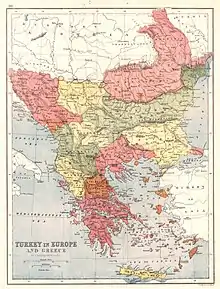 Vilayets of Europe in 1870
Vilayets of Europe in 1870_The_Bosphorus_and_Vicinity._Copyright%252C_1877%252C_by_O.W._Gray_%2526_Son.jpg.webp) Vilayets in 1877
Vilayets in 1877_The_Bosporus_%2526_Constantinople._(with)_Crete_or_Candia._By_Keith_Johnston%252C_F.R.S.E._Keith_Johnston's_General_Atlas._Engraved%252C_Printed%252C_and_Published_by_W._%2526_A.K._Johnston%252C_Edinburgh_%2526_London.jpg.webp) Vilayets of Europe in 1893
Vilayets of Europe in 1893.jpg.webp) Vilayets of Asia in 1897
Vilayets of Asia in 1897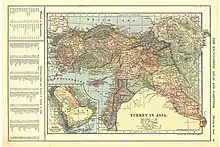 Vilayets of Asia in 1909
Vilayets of Asia in 1909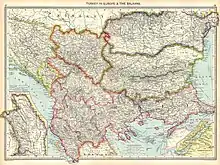 Vilayets of Europe in 1910
Vilayets of Europe in 1910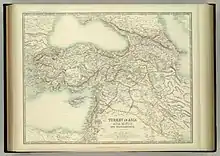 Vilayets of Asia in 1911
Vilayets of Asia in 1911
See also
- Provinces of Turkey
- Six Vilayets, the Armenian vilayets of the empire
- Vilayet Law
References
- Birken, Andreas (1976). Die Provinzen des Osmanischen Reiches. Beihefte zum Tübinger Atlas des Vorderen Orients (in German). Vol. 13. Reichert. p. 22. ISBN 9783920153568.
- One or more of the preceding sentences incorporates text from a publication now in the public domain: Caillard, Vincent Henry Penalver (1911). "Turkey". In Chisholm, Hugh (ed.). Encyclopædia Britannica. Vol. 27 (11th ed.). Cambridge University Press. p. 428.
- Report of a Committee Set Up to Consider Certain Correspondence between Sir Henry McMahon (His Majesty's High Commissioner in Egypt) and the Sharif of Mecca in 1915 and 1916 (PDF), 2015, archived from the original (PDF) on 2015-06-21, Annex A, §10. 2nd Source.
- File:Solun Newspaper 1869-03-28 in Bulgarian.jpg
- Strauss, Johann (2010). "A Constitution for a Multilingual Empire: Translations of the Kanun-ı Esasi and Other Official Texts into Minority Languages". In Herzog, Christoph; Malek Sharif (eds.). The First Ottoman Experiment in Democracy. Würzburg: Orient-Institut Istanbul. pp. 21–51. (info page on book at Martin Luther University) // CITED: p. 41-43 (PDF p. 43-45/338).
- Birken, Andreas (1976). Die Provinzen des Osmanischen Reiches. Beihefte zum Tübinger Atlas des Vorderen Orients (in German). Vol. 13. Reichert. pp. 19–20. ISBN 9783920153568.
- Krikorian, Mesrob K. (2018). Armenians in the Service of the Ottoman Empire: 1860-1908. Routledge. p. 24. ISBN 978-1351031288. Retrieved 11 February 2022.
- Birken (1976), p. 2324.
- Abel Pavet de Courteille (1876). État présent de l'empire ottoman (in French). J. Dumaine. pp. 91–96.
- A handbook of Asia Minor Published 1919 by Naval staff, Intelligence dept. in London. Page 226
- One or more of the preceding sentences incorporates text from a publication now in the public domain: Hogarth, David George (1911). "Bengazi". In Chisholm, Hugh (ed.). Encyclopædia Britannica. Vol. 3 (11th ed.). Cambridge University Press. p. 736.
- Palestine; A Modern History (1978) by Adulwahab Al Kayyali. Page 1
- One or more of the preceding sentences incorporates text from a publication now in the public domain: Socin, Albert; Hogarth, David George (1911). "Lebanon". In Chisholm, Hugh (ed.). Encyclopædia Britannica. Vol. 16 (11th ed.). Cambridge University Press. p. 348.
Further reading
- Sublime Porte (1867). Sur la nouvelle division de l'Empire en gouvernements généraux formés sous le nom de Vilayets. Constantinople.
{{cite book}}: CS1 maint: location missing publisher (link) - About the Law of the Vilayets
External links
- Vilayet Law of 1864, official translation to French pp. 36–45, in Young, George, Corps de droit ottoman; recueil des codes, lois, règlements, ordonnances et actes les plus importants du droit intérieur, et d'études sur le droit coutumier de l'Empire ottoman, Volume 1, 1905.
- Vilayet Law of 1867, in French, in Législation ottomane, published by Gregory Aristarchis and edited by Demetrius Nicolaides, Volume 2